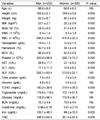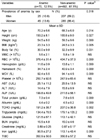1. Ania BJ, Suman VJ, Fairbanks VF, Melton LJ III. Prevalence of anemia in medical practice: community versus referral patients. Mayo Clin Proc. 1994. 69:730–735.

2. Ania BJ, Suman VJ, Fairbanks VF, Rademacher DM, Melton LJ III. Incidence of anemia in older people: an epidemiology study in a well-defined population. J Am Geriatr Soc. 1997. 45:825–831.
3. Baik HW, Russell RM. Vitamin B12 deficiency in the elderly. Annu Rev Nutr. 1999. 19:357–377.
4. Balducci L. Epidemiology of anemia in the elderly: information on diagnostic evaluation. J Am Geriatr Soc. 2003. 51:S2–S9.

5. Blumberg WE, Eisinger J, Lamola AA, Zuckerman DM. Zinc protoporphyrin level in blood determined by a portable hematofluorometer: a screening device for lead poisoning. J Lab Clin Med. 1977. 89:712–723.
6. Carmel R. Anemia and aging: an overview of clinical, diagnostic and biological issues. Blood Rev. 2001. 15:9–18.

7. Celestin-Roux C, Hale WE, Perkins LL, Stewart RB. Anemia: evaluation of age, sex, disease and medication in the elderly. Journal of Geriatric Drug Therapy. 1987. 1:63–86.
8. Choi CW, Lee J, Yoon SY, Choi IK, Oh SC, Seo JH, Kim BS, Shin SW, Kim YH, Kim JS. Prevalence and characteristics of anemia in the elderly: Cross-sectional study of three urban Korean population samples. Am J Hematol. 2004. 77:26–30.

9. DeMaeyer E, Adiels-Yagman M. The prevalence of anemia in the world. World Health Stat Q. 1985. 38:302–316.
10. Hake WE, Stewart RB, Marks RG. Hematology and biochemical values in an ambulatory elderly population. Age Ageing. 1983. 12:275–284.
11. Izaks GJ, Westendorp RG, Knook DL. The definition of anemia in older persons. JAMA. 1999. 281:1714–1717.

12. Kikuchi M, Inagaki T, Shinagawa N. Five-year survival of older people with anemia: variation with hemoglobin concentration. J Am Geriatr Soc. 2001. 149:1226–1228.

13. Kim JS, Kim MK, Kim HS. Regional comparison of dietary intakes and health related behaviors among residents in Asan. Nutrition Research and Practice. 2007. 2:143–149.

14. Lipschitz DA, Mitchell CO, Thompson C. The anemia of senescence. Am J Hematol. 1981. 11:47–54.

15. Ma JZ, Ebben J, Xia H, Collins AJ. Hematocrit levels and associated mortality in hemodialysis patients. J Am Soc Nephrol. 1999. 10:610–619.
16. Moreno F, Sanz-Guajardo D, Lopez-Gomez JM, Jofre R, Valderrabano F. Increasing hematocrit has a beneficial effect on quality of life and is safe in selected hemodialysis patients. J Am Soc Nephrol. 2000. 11:335–342.

17. Nissenson AR, Goodnough LT, Dubois RW. Anemia, not just an innocent bystander? Arch Intern Med. 2003. 162:1400–1404.
18. Salive ME, Cornoni-Huntley J, Guralink JM, Phillips CL, Wallace RB, Ostfeld AM, Cohen HJ. Anemia and hemoglobin levels in older persons: relationship with age, gender, and health status. J Am Geriatr Soc. 1992. 40:489–496.

19. Smith DL. Anemia in elderly. Am Fam Physician. 2000. 62:1565–1572.
20. Stander PE. Anemia in the elderly. Postgrad Med. 1989. 85:85–96.

21. Timiras MS, Brownstein H. Prevalence of anemia and correlation of hemoglobin with age in a geriatric screening clinic population. J Am Geriatr Soc. 1987. 35:639–643.

22. Zauber NP, Zauber AG. Hematologic data of healthy very old people. JAMA. 1987. 257:2181–2184.







 PDF
PDF ePub
ePub Citation
Citation Print
Print




 XML Download
XML Download